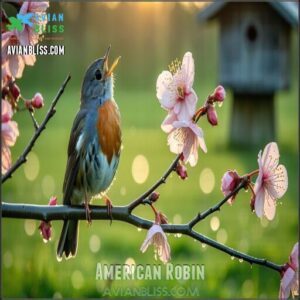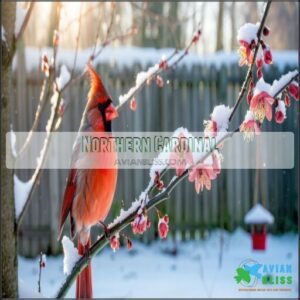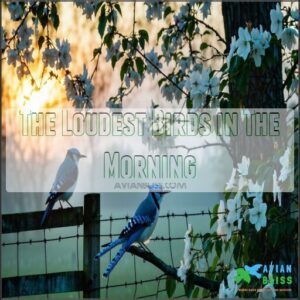This site is supported by our readers. We may earn a commission, at no cost to you, if you purchase through links.

These birds are the stars of the dawn chorus, singing to attract mates, defend territory, or simply announce their presence. The robin’s cheerful tune, the cardinal’s clear whistles, and the thrush’s melodic shower of notes are among the first sounds of the day.
Even Red-winged Blackbirds chime in if you’re near wetlands. Their singing isn’t random—it’s nature’s way of keeping things in balance.
Curious about why mornings are their favorite stage? Stick around to find out about the dawn chorus and how it’s all part of nature’s balance.
Table Of Contents
- Key Takeaways
- Common Morning Birds in North America
- Morning-Singing Birds in Other Regions
- Why Do Birds Chirp in The Morning?
- Notable Birds With Distinctive Morning Songs
- The Loudest Birds in The Morning
- Celebrating International Dawn Chorus Day
- Tools for Identifying Birds by Sound
- The Fascinating Behavior of The Dawn Chorus
- Spiritual Significance of Morning Bird Chirping
- Tips for Enjoying The Morning Bird Chorus
- Frequently Asked Questions (FAQs)
- What is the first bird to chirp in the morning?
- What does it mean when a lot of birds are chirping in the morning?
- What bird makes that noise in the morning?
- What does it mean when birds chirp around your house?
- How does noise pollution affect morning bird songs?
- Do birds chirp differently in urban areas?
- What time does the dawn chorus typically begin?
- Are there birds that don’t join the dawn chorus?
- How do seasons impact morning bird activity?
- What birds chirp at dawn in urban areas?
- Conclusion
Key Takeaways
- You’ll hear birds like American Robins, Northern Cardinals, and Song Thrush serenading the morning to attract mates or defend territory.
- Birds sing early because the air is calmer, helping their songs travel farther during the dawn chorus.
- Urban birds adapt their songs to be louder or simpler to compete with city noise, making them just as present in bustling areas.
- Some birds, like owls and nightjars, skip the dawn chorus, while others, like mockingbirds, mimic diverse sounds even at sunrise.
Common Morning Birds in North America
You’ll often hear the cheerful songs of the American Robin, Northern Cardinal, and Red-winged Blackbird greeting the sunrise across North America.
The joyful melodies of robins, cardinals, and blackbirds create a harmonious dawn greeting across North America.
Each species has a unique song, from the robin’s rich, melodic phrases to the cardinal’s whistles and the blackbird’s distinctive “conk-la-reee,” which are complete concepts that help identify these birds.
American Robin
What makes the American Robin stand out among early morning birds? It’s their joyful "cheerily, cheer up" morning bird songs, calling as early as 4 AM to mark territory or attract mates.
These common backyard birds are easy to spot, thanks to their orange-breasted Robin Plumage, as they forage for earthworms, a staple of the Robin Diet.
Some breeders use special food products to guarantee healthy growth.
Seasonal Robin Migration reminds us to appreciate their role in Robin Conservation, as their chirping sounds become a cherished dawn ritual, or gather twigs during Robin Nesting season.
Northern Cardinal
The Northern Cardinal, a superstar among common backyard birds, fills mornings with its unmistakable "cheer-cheer-cheer" whistles. These vibrant songsters, adored for their bold red feathers and striking presence, are a staple in North America’s dawn symphonies.
Cardinal vocalizations stand out for their complexity. Here’s what makes them special:
- Males and females sing—a rarity among birds that chirp.
- Each morning bird song combines up to 21 distinct syllables.
- Regional variations make their songs unique to different places.
- Songs, lasting 2-3 seconds, require precise muscle control.
- Males sing year-round, defending their turf with gusto.
Northern Cardinals thrive in shaded spaces and suburban yards, where you’ll hear their bold, trilling melodies. Offering quality seeds for birds can further attract them to your yard. To attract these beauties, provide dense shrubs, sunflower seeds, and water sources—ideal for watching nature’s ultimate performers.
Red-winged Blackbird
You might hear birds chirping sounds like “conk-la-ree!” greeting the sunrise near marshes or fields. That’s the Red-winged Blackbird flaunting its charm. Male blackbirds perch high, showing off bold red-and-yellow shoulder patches while singing brassy calls to stake out territory.
Females, with their streaked brown plumage, work on nesting nearby.
Here’s a quick snapshot of these early singers:
| Feature | Males | Females |
|---|---|---|
| Plumage Color | Black with red shoulders | Streaked brown |
| Habitat | Marshes, wetlands | Same |
| Diet | Insects, seeds | Similar |
| Behavior | Territorial singing | Nest building |
| Migration | Seasonal in some regions | Same |
Habitat variation keeps them adaptable, even amid morning bustle or noise pollution. Their preferred nesting locations often include cattails and bulrushes.
Recognizing birds singing at sunrise becomes easier with their distinctive calls and stunning displays.
Morning-Singing Birds in Other Regions
You’ll find that morning birds across different regions bring their own unique charm to the dawn chorus.
From the fluty phrases of the Song Thrush in Europe to the rhythmic "chiff chaff" of the Common Chiffchaff in forested areas, their songs highlight the diversity of bird species and their habitats.
Song Thrush (Europe, Middle East, Northern Africa)
The Song Thrush is a virtuoso of the dawn chorus, charming listeners from Europe’s woods to North Africa’s gardens.
Its fluty phrases and intricate song variations—over 100 distinct patterns—make it a natural star of morning birdsong. You’ll often hear its rhythmic, repeated phrases that sound almost like nature’s poetry lesson.
This bird thrives in habitats with dense undergrowth, such as woodland edges and parklands. It’s not shy about showing its regional differences either, adjusting its songs slightly depending on where it roams. And roam it does! Many Song Thrushes migrate to warmer Mediterranean spots during winter.
Why does this melodious bird matter? Its conservation status highlights the importance of maintaining green spaces for wildlife.
- Listen for repeating song patterns in the dawn chorus.
- Spot them near hedgerows or forest clearings.
- Appreciate their role in bird identification.
- Support conservation efforts in urban gardens.
- Enjoy a musical reminder of nature’s beauty.
Common Chiffchaff (European Deciduous Forests)
Let’s talk about the Common Chiffchaff, one of Europe’s favorite dawn chorus birds.
This olive-brown warbler thrives in European woodlands, filling them with its charming "chiff-chaff" duet. It’s a master of bird song identification, thanks to its two-note rhythm.
You’ll find them nesting in Chiffchaff habitat: deciduous and mixed forests. Come winter, they set out on a winter migration to Africa.
Although abundant, their conservation status faces challenges from habitat loss. Supporting deciduous adaptation efforts and wetland protection guarantees their melodies continue for future mornings.
| Trait | Description |
|---|---|
| Size | Small warbler |
| Color | Olive-brown, yellow hints |
| Habitat | Deciduous forests |
| Song Variation | Two-note "chiff-chaff" song |
| Migration Pattern | Europe to sub-Saharan Africa |
Why Do Birds Chirp in The Morning?
You’ve probably noticed birds erupting into song at sunrise, but there’s more to it than just greeting the day.
They chirp to attract mates, defend their territory, and sometimes to signal good feeding spots, making morning the perfect time to be heard.
Attracting Mates
Picture the golden hour filled with bird songs—it’s not just pretty noise, it’s love in the air.
Male morning birds, like the Red-winged Blackbird and Song Thrush, use tunes as romantic pitches. Their songs are filled with song complexity and charm, all for female choice in the courtship game.
- Vocal duets showcasing harmony and compatibility.
- Mating displays rich in rhythm and creativity.
- Clues about hormonal influence, signaling a strong mate.
- Bird sounds suggesting stamina and health.
For these dawn chorus birds, love truly sings.
Marking Territory
In the early hours, birds aren’t just singing—they’re defending their turf.
Those morning bird songs broadcast bold claims about territory ownership, warning rivals to stay away. It’s like nature’s version of fencing with feathers.
- Aggressive calls deter intruders by showcasing dominance.
- Song overlap during the dawn chorus can be part of rivalry.
- Larger territory size often means louder, more frequent chirping.
Next time, try morning bird identification to decipher their backyard defense strategies!
Seeking Food
After staking their claim with vibrant calls, birds get to work on their breakfast.
Morning chirping often signals the beginning of clever foraging strategies. Flycatchers perform aerial flips to snap up insects, while woodpeckers hammer tree bark for hidden protein.
Sparrows scratch through leaf litter, unearthing seeds and beetles, while meadowlarks comb fields for worms. Birds like orioles focus on their sweet tooth, plucking berries and fruit from shrubs.
For species that chirp in winter, feeding shifts to scavenging seeds or leftover fruit. This orchestra of activity guarantees food sources are secured early—a lifesaving advantage when competing for scarce nutrients, ensuring a successful start to their day with vibrant calls and clever adaptations.
Notable Birds With Distinctive Morning Songs
You’ll find some birds stand out with their unique morning songs that are both enchanting and practical.
Species like the Gartered Trogon and Tufted Titmouse use their distinctive calls to communicate, defend territory, or attract mates in their respective habitats.
Gartered Trogon (humid Areas From Mexico to Venezuela)
Far from your backyard sparrows, the Gartered Trogon lends a tropical charm to mornings in humid forests from Mexico to Venezuela.
Its mellow “kyu-kyu-kyu” vocalizations float through lush canopies alive with bird sounds, making it a standout among early risers.
This bird’s striking red, yellow, and blue plumage, paired with its long tail, makes spotting one as exciting as hearing its morning chirping.
Living in steamy rainforest habitats, it often sings to claim territory or attract a mate.
Curious about its unique bird vocalization types? Use tools like the Merlin app or bird recordings to explore the magic of this vibrant species in its natural Trogon habitat.
Tufted Titmouse (Eastern U.S. Resident in Deciduous Forests)
The tufted titmouse is a delightful presence, especially if you’re familiar with garden bird sounds while wandering through deciduous forests in the eastern U.S.
Its unmistakable “peter-peter-peter” call is a signature feature among birds that chirp early, bringing life to oak trees and maples.
Known for its soft gray feathers, bold black forehead, and adorable crest, this tiny bird stands out.
You’ll often catch its cheerful tunes as it busily hops through branches or visits feeders.
Active and curious, its behavior makes it a favorite for bird enthusiasts.
They build nests using a variety of materials, including animal fur for warmth.
- Titmouse Habitat: Deciduous forests, particularly oaks.
- Titmouse Diet: Seeds, nuts, insects, berries.
- Titmouse Conservation: Stable populations, loved by birdwatchers.
- Titmouse Nesting: Utilizes cavities in trees or birdhouses.
The Loudest Birds in The Morning
Some birds don’t just join the dawn chorus—they steal the show with sheer volume.
The Northern Mockingbird is famous for its ability to mimic other bird sounds, insects, and even car alarms, turning mornings into concertos.
The White Bellbird, holding the title of the loudest bird, reaches decibel levels of 125 with its piercing calls, powerful enough to feel like nature’s alarm clock.
You’ll also hear Blue Jays, whose sharp, attention-grabbing calls serve as territorial warnings.
Owls, including the Barred Owl, add haunting notes to the pre-dawn ambience.
Even the Common Loon, a lake-dwelling star, contributes haunting echoes.
These birds singing early captivate attention as well as raise questions about hearing impact and how bird vocal anatomy creates such dramatic noise pollution in spring mornings.
Morning songs help birds defend their territory.
Celebrating International Dawn Chorus Day
International Dawn Chorus Day is your chance to celebrate the enchanting melodies of birds singing early.
Originating in the UK, this global event inspires birdsong appreciation in over 80 countries.
Participate by enjoying local events, listening to the dawn chorus, or learning to identify bird songs. Start with bird-friendly essentials like binoculars and a guide.
Supporting conservation efforts or sharing recordings amplifies the movement. Whether from your backyard or at organized celebrations, connect with nature’s symphony, appreciating its beauty while contributing to bird conservation.
Experience peace and the shared joy of this magical morning tradition.
Tools for Identifying Birds by Sound
Identifying bird sounds has turned into an exciting hobby with today’s tools.
Sound Recording Apps like Merlin instantly match chirps to species using birdsong analysis software. Prefer hands-free? Try Acoustic Monitoring Devices like Haikubox for real-time insights.
For enthusiasts, parabolic microphones capture distant melodies, while sound spectrograms visualize chirps for deeper bird song analysis. Each tool acts as a bird song guide, helping you explore unique calls.
Whether you’re deciphering the dawn chorus or learning regional accents, bird identification apps make it easy. Go ahead—become nature’s composer, guided by the symphony of bird sounds!
To improve your skills, try creating helpful mnemonics for each bird’s unique song.
The Fascinating Behavior of The Dawn Chorus
The dawn chorus is like nature’s orchestra, beginning with soft notes that crescendo into an intricate symphony. This display of birdsong isn’t random—it’s a fascinating example of vocal learning and communication.
Morning birds create a symphony at sunrise, blending melody and purpose—a perfect harmony of nature’s rhythm and connection.
Morning birds use this time to mark their territory, attract mates, and strengthen social bonds, all while showcasing their song complexity. The timing is no accident.
Early hours provide still, quiet air, letting bird sounds in spring travel farther. For male birds, the dawn chorus is part charm, part competition—proving their fitness through vocal mastery.
You’ll notice varied styles: robins with bold melodies or finches with cheerful trills. Urban choruses may adapt higher-pitched songs to cut through city noise.
Studying the dawn chorus gives insight into birds’ sleep patterns, morning behaviors, and the evolution of their songs. Embrace this magical performance as a serene start to your day!
Spiritual Significance of Morning Bird Chirping
The soft melodies of morning birds aren’t just nature’s alarm clock—they’re a kind of cosmic language.
Their songs symbolize new beginnings, a fresh chapter unfolding with the sunrise. Cultures around the globe see birdsong as a form of divine connection, a gentle nudge from nature to pause and listen.
The Dawn Chorus, made up of chirping robins, cardinals, or chiffchaffs, carries spiritual significance. These morning birds often remind us to embrace hope or reconnect with our surroundings.
Some believe their melodies are nature’s messages, whispering that prayers have been heard or offering comfort through inner peace.
Use their songs as a form of spiritual awakening—just like a soothing mantra during meditation. The beauty of birdsong reveals harmony between earth and sky, grounding your day with quiet inspiration.
Tips for Enjoying The Morning Bird Chorus
Nothing compares to the beauty of a dawn chorus—nature’s symphony at sunrise.
Here’s how to fully enjoy it:
- Optimal Timing: Set your alarm early to catch backyard bird songs at their peak, usually during sunrise. Remember, the early bird gets the best concert!
- Garden Sanctuaries: Find a peaceful spot like your backyard or a local park for uninterrupted bird watching. Quiet surroundings amplify those harmonious bird sounds.
- Bird Sounds Identification: Bring a recording device or use apps like Merlin to recognize individual songs. Explore birding etiquette by observing but not disturbing.
- Citizen Science: Take notes or contribute recordings to community projects tracking bird activity. The songs also serve to defend their territory.
- Stay Present: Relax, breathe, and let each chirp sink in. These fleeting moments connect you to nature’s gentle rhythm.
Frequently Asked Questions (FAQs)
What is the first bird to chirp in the morning?
The Northern Mockingbird often wakes up first, singing loudly before dawn.
It’s like nature’s alarm clock, mimicking other bird calls and even environmental sounds to kickstart the morning orchestra while the world’s still groggy.
What does it mean when a lot of birds are chirping in the morning?
When birds chirp loudly in the morning, it’s like nature’s orchestra warming up.
They’re claiming territory, wooing mates, or warning others.
These vibrant morning songs create harmony while ensuring their survival—it’s nature’s way to maintain balance.
What bird makes that noise in the morning?
Imagine nature’s alarm clock—chirping American Robins, Song Thrushes, or cheerful Chaffinches filling the air with melody.
They chirp to claim territory, find mates, or simply welcome daylight, making mornings feel alive and connected, as they chirp to initiate their daily activities.
What does it mean when birds chirp around your house?
When birds chirp around your house, they’re marking territory, attracting mates, or signaling safety.
It’s nature’s way of saying your home feels welcoming—kind of like hosting a bird brunch without serving worms!
How does noise pollution affect morning bird songs?
Noise pollution drowns out bird songs, forcing them to sing louder, higher-pitched, or adjust timing.
It’s like competing at karaoke with a malfunctioning mic, making it harder for birds to attract mates or defend territory effectively, which can be seen as a form of noise pollution that affects their ability to attract mates.
Do birds chirp differently in urban areas?
In bustling cities, birds adapt their songs, like urban jazz musicians.
They sing earlier, louder, and with simpler tunes to outcompete street noise, ensuring their melodies reach mates and rivals amidst the concrete chaos.
What time does the dawn chorus typically begin?
The dawn chorus usually starts about 30 minutes before sunrise, triggered by natural light changes.
Birds prefer singing early since cooler, calmer air helps their songs travel farther, making it the perfect time to impress.
Are there birds that don’t join the dawn chorus?
Yes, some birds skip the dawn chorus.
Nocturnal species like owls and nightjars are busy during the night instead.
Others, like hawks, stay quiet to maintain stealth while hunting—singing just isn’t their thing.
How do seasons impact morning bird activity?
Seasons tweak bird activity like setting a morning alarm.
In spring, mating calls dominate as daylight grows, while winter hushes chirps because food’s scarce.
Summer brings variety, and fall showcases farewell songs before migration.
What birds chirp at dawn in urban areas?
In urban areas, you’ll hear mockingbirds mimicking sounds, robins cheerfully singing, sparrows chirping briskly, and occasionally, cardinals whistling distinct tunes.
These adaptable birds fill the morning air, adapting effortlessly to city life’s rhythm.
Conclusion
Birdsong in the morning is like nature’s symphony, with vibrant melodies from the American Robin, Northern Cardinal, and Song Thrush setting the stage.
These early risers chirp to attract mates, defend territories, or simply make their presence known.
Whether you’re near wetlands or forests, you’ll notice a variety of singers each day.
Understanding what kind of birds chirp in the morning connects you to their world and highlights their role in balancing ecosystems.
Listen, and enjoy nature’s harmony!
















